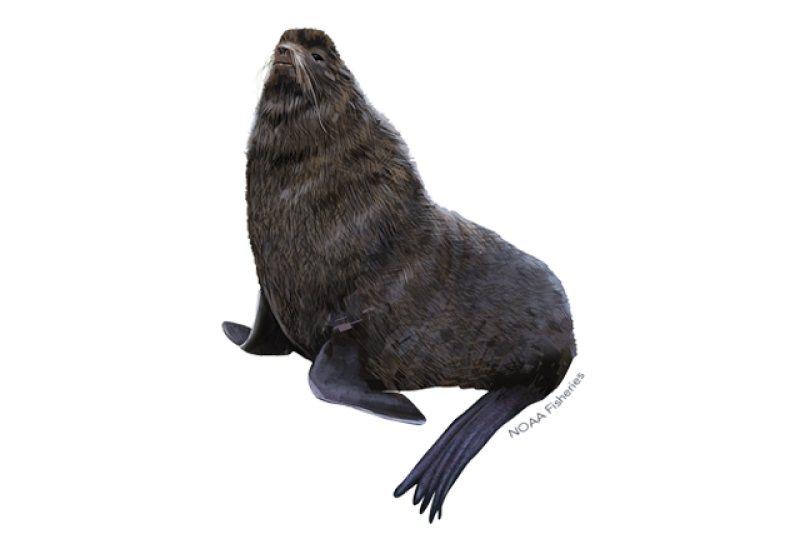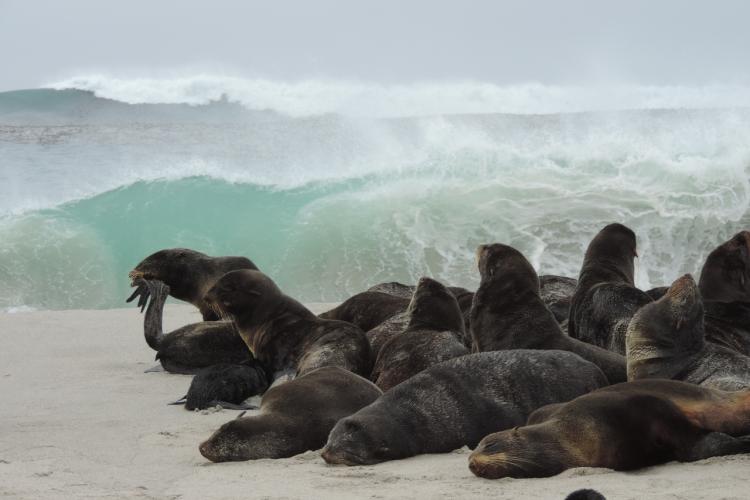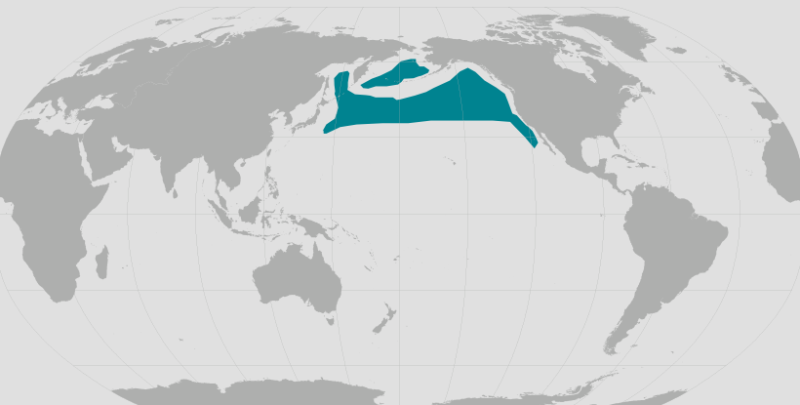
Northern fur seals are members of the "eared seal" family. They primarily use the open ocean for foraging and rocky beaches for resting, molting, and reproduction. Historically, northern fur seals were hunted for their fur on land and at sea.

Entanglement in Marine Debris and Lost or Abandoned Fishing Gear, Effects of Fisheries on Prey , Climate Change, Environmental Contaminants, Predation
Alaska, West Coast
Northern fur seals haul out on San Miguel in the Channel Islands, California - Photo: NOAA Fisheries/Kristin Wilkinson, NMFS Stranding Coordinator
Northern fur seals haul out on San Miguel in the Channel Islands, California - Photo: NOAA Fisheries/Kristin Wilkinson, NMFS Stranding Coordinator

Northern fur seals haul out on San Miguel in the Channel Islands, California - Photo: NOAA Fisheries/Kristin Wilkinson, NMFS Stranding Coordinator
Northern fur seals haul out on San Miguel in the Channel Islands, California - Photo: NOAA Fisheries/Kristin Wilkinson, NMFS Stranding Coordinator
Northern fur seals are members of the "eared seal" family (Otariidae). They spend most of the year in the ocean. Weaned pups typically spend nearly 2 years away before returning to their breeding colonies. Northern fur seals primarily use open ocean for foraging and rocky beaches for resting, molting, and reproduction.
Historically, northern fur seals were hunted for their fur on land and at sea. In 1911, the Fur Seal Treaty created an international prohibition on hunting fur seals at sea and shared responsibility among the treaty nations for commercial harvests on land. In 1984, the United States ended commercial harvest of northern fur seals on the Pribilof Islands. Subsistence use is currently co-managed by NOAA Fisheries and the tribal governments of St. Paul and St. George.
Northern fur seals, like all marine mammals, are protected under the Marine Mammal Protection Act. The Pribilof Islands/eastern Pacific stock is listed as depleted under the MMPA. In addition, Northern fur seals are also protected under the Fur Seal Act.
NOAA Fisheries is committed to conserving and protecting northern fur seals. Our scientists and partners use a variety of innovative techniques to study, learn more about, and protect this species.
In 1988, the Pribilof Islands population was designated as a depleted stock under the MMPA because it had declined by more than 50 percent from its estimated population of 2.1 million seals in the 1950s. This stock was reclassified in 1994 as the eastern Pacific stock, which includes the Pribilof Islands population and a newly established breeding site on Bogoslof Island, and the California stock, which breeds on San Miguel and the Farallon Islands off the coast of California. The California Stock is significantly smaller than the eastern Pacific stock. Estimated at 14,050 northern fur seals in 2016, it is smaller than the populations on St. Paul, St. George, or Bogoslof Islands. Trends in abundance since the designation of the eastern Pacific stock are different for individual islands and even among breeding areas. Temporary increases in the overall stock size are observed when opportunistic estimates are conducted at Bogoslof, but declines at St. Paul continue to drive the overall stock estimate down over time. The annual pup production estimates for the Eastern Pacific stock have been declining at 1.80 percent per year from 1999 to 2019, but only at 0.55 percent (95% CI: -2.11 to 1.06; not significantly different from 0) per year from 2009 to 2019. The 2019 abundance estimate for the eastern Pacific stock is 626,618.
The first northern fur seals to populate San Miguel Island migrated from the Pribilof Islands, as seals tagged on the Pribilofs were observed on San Miguel among breeding California sea lions. The population grew 46 percent in the 1950s and early 1960s but afterward experienced declines due to major El Niño events. The population began to recover in 1999, but it has been affected by subsequent El Niño events, often resulting in the deaths of all newborn pups. A small population has been observed breeding on South Farallon Island (off the California coast).
Commercial sealing on t he Commander Islands, Kuril Islands, and Robben Islands in Asia caused a severe decline of northern fur seals in the early 1900s. The number of seals also declined on all three islands between the late 1960s and the late 1980s. The Robben Island population now appears to be recovering.
Northern fur seals have a stocky body, small head, very short snout, and extremely dense fur (46,500 fibers/cm²) that ends at the wrist lines of their flippers. Their flippers are the longest in the Otariidae family. Their hind flippers can measure up to one-fourth of their total body length. Their fore flippers are incredibly strong allowing them to walk or run on all fours. They can outrun a human on slippery rocks and can climb nearly vertical cliffs. Northern fur seals exhibit sexual dimorphism, which means that adult males are much larger (up to 370 percent) than adult females. Males can grow to 7 feet and weigh up to 600 pounds, while females can grow to 5 feet and weigh up to 120 pounds. Pups are uniformly black until they molt when they are around 3 months old and they are a silver-gray color.
Adult males are dark brown to black, and adult females are dark gray or brown on their backs and light gray, silver, or cream on their throat, chest, and stomach. They have whiskers on their snout, known as vibrissae. Pups are born with black vibrissae. Their vibrissae grow throughout their lives and progressively turn white as the age and adults have prominent white vibrissae.
Northern fur seals are a highly pelagic (live in the open ocean), are thought to be mostly solitary at sea , nocturnal species. They are known to be aggressive on land, especially during the breeding season. Adult males forcefully defend their breeding territory site. Male to male aggression is most frequently used in defense of territories and consists of pushing and biting, sometimes to the death. Female to female aggression is frequent but mild (open mouth threat). Intense female to female aggression (biting and pushing) is rare.
Northern fur seals are described as generalist or opportunistic foragers, consuming a wide variety of midwater fish and squid species. Walleye pollock is the predominant prey of northern fur seals that forage over the Bering Sea shelf. They consume greater amounts of oceanic fish and squid species when they forage over the slope and in off-shelf waters. Other primary prey include Pacific sand lance, Pacific herring, Northern smoothtongue, Atka mackerel, and Pacific salmon. The northern fur seal diet differs depending on geographic area and time of year. Northern fur seal diet and tracking (telemetry) studies indicate they forage in colony-specific areas, while they use their preferred land sites for resting, reproduction , and rearing their young.
Northern fur seals primarily inhabit two types of habitat: open ocean and rocky or sandy beaches on islands for resting, reproduction, and molting.
Northern fur seals seasonally breed on six islands in the eastern North Pacific Ocean and Bering Sea in the United States—St. Paul, Bogoslof, St. George, Sea Lion Rock, San Miguel, and South Farallon. They also breed on the Commander Islands, Kuril Island, and Robben Island.
The Pribilof Islands support the largest aggregation of northern fur seals, which breed on St. Paul, St. George, and Sea Lion Rock (about half of the world's northern fur seal population). Non-breeding northern fur seals haul-out on Walrus Island and Otter Island which are also part of the Pribilof Islands.
Adult northern fur seals spend more than 300 days per year (about 80 percent of their time) at sea. During the summer and autumn they intermittently fast while on land and feed at sea. During the winter and spring they are pelagic, occupying the North Pacific Ocean as well as the Bering and Okhotsk Seas. In the open ocean, concentrations of northern fur seals may occur around oceanographic features—such as eddies, convergence-divergence zones, and frontal boundaries—because of the availability of prey in those places. In the winter, the southern boundary of the northern fur seal range extends across the Pacific Ocean, between southern California and Honshu Island, Japan, but they are found as far north as the Bering Sea. In the spring, most northern fur seals migrate north to breeding colonies in the Bering Sea. Territorial adult male northern fur seals leave their breeding colonies in August and are thought to spend most of their time in the Bering Sea and North Pacific Ocean along the Aleutian Islands. Pregnant adult females begin their winter migration in November and generally travel to either the central North Pacific Ocean or to offshore areas along the west coast of North America to feed. Some northern fur seals may spend all year in the waters around San Miguel Island, California.

Northern Fur Seal Range Map
Male northern fur seals can live up to 18 years, while females can live up to 27 years. Beginning in May, male seals start returning to the breeding islands. Adult males, or bulls, arrive first to occupy and defend prime breeding territories before the females arrive. A male’s ability to mate depends on several factors, such as body size, fighting ability, size and location of the chosen breeding territory, and skill at interacting with females. Because males do not leave the breeding territory to feed, their ability to fast is critical. Males remain on their territory an average of 46 days, losing 32 percent of their body mass. Breeding males are typically 10 or more years old and maintain females within their territories. About 30 percent of the adult males on land breed with females during the summer. Adult males are counted annually during the peak of the breeding season as an index of the population size. They are categorized as territorial with females, territorial without females, or non-territorial. Territorial males abandon their breeding sites in August, allowing non-territorial males to occupy these same sites, but the vast majority of adult females have already mated at this point. Adult males exclude juvenile males from the breeding areas. Juveniles instead congregate on land in areas called "haulouts" during the summer breeding season. The haulouts can be located inland, typically behind the breeding areas, or adjacent to the breeding areas. The typical structure of northern fur seal terrestrial habitat includes the central area occupied by breeding males with females, surrounded by territorial adult males without females on the fringe, non-territorial adult males, and juvenile males on haulouts outside the breeding areas.
Females generally have their first pup at 5 to 6 years of age and are in their reproductive prime between the ages of 8 and 13. They are not selective in their choice of mate, but they do show an affinity for a specific breeding site. Females typically start returning to the breeding islands in late June and give birth to a single pup 1.3 days after arrival on land. Mating occurs within 5.3 days of giving birth. Female northern fur seals undergo embryonic diapause, meaning the embryo does not immediately implant in the uterus and is thought to be delayed until after lactation, or weaning. Females suckle their newborn pups for 5 to 6 days and then go to sea to forage for 3.5 to 9.8 days. Females continue to cycle between land and sea for the remainder of the nursing period. Their time on land declines to less than two days and their time at sea generally increases. Pups are nursed until weaning (about 4 months) and leave the breeding site before their mothers to forage independently for the first time .
Northern fur seals can become entangled in lost or abandoned fishing gear such as trawl webbing, packing bands and monofilament nets, or other marine debris, either swimming off with the gear attached or becoming anchored. Fur seals encounter marine debris at sea. Fur seals seasonally migrate, spending most of their time in the North Pacific Ocean foraging in the transition zone and spending time in eddies while migrating. These oceanographic features concentrate nutrients and prey, and also marine debris. They also encounter marine debris in the Bering Sea during their foraging trips to and from their breeding and resting areas on land. Once entangled, seals may drag and swim with attached gear for long distances, ultimately resulting in fatigue, compromised feeding ability, or severe injury, which may lead to reduced reproductive success and death.
The type of available prey, access to prey, and distribution of prey can change for a variety of reasons. For example, regional and local prey can change because of changes in climate, oceanography, and the overall complexity of the oceans ecosystem. Cumulative and annual commercial fisheries removals may result in temporal and seasonal changes in distribution and abundance of primary prey, prey reduction, and changes in prey size; they may also cause ecosystem effects. All of these may affect fur seals’ ability to reliably access sufficient prey to sustain the health, reproduction, and survival of individuals and support sustained increase and eventual recovery of the population. Very few fur seals are observed captured in active fishing nets (i.e., bycatch). Indirect commercial fishery effects can include competition for commercial fish species.
Global climate change is expected to have profound impacts on arctic and sub-arctic marine ecosystems. This may affect the composition, spatial and temporal distribution, and abundance of prey available to fur seals.
Sea level rise caused by climate change may directly alter access to or the utility of terrestrial rookery and haulout sites currently used by fur seals. Traditional sites on some islands with low relief may be submerged, but other habitat may become accessible.
Decadal scale regime shifts, and shorter-term oceanographic anomalies such as El Niño Southern Oscillation (ENSO) events and marine heatwaves, also can have large effects on distribution and abundance of fur seal prey. Marine heatwaves have already shown to reduce fur seal survival.
Ocean acidification effects on fur seals are uncertain but are likely to include serious impacts on ecosystems and may have adverse effects on specific species prey through food web effects.
Harmful algal bloom (HAB) toxins cause sickness and death in humans and fur seals. Warming water temperatures increases toxic algae growth, prevents water from mixing, allowing algae to grow thicker and faster, and algal blooms absorb sunlight, making water even warmer and promoting more blooms.
Contaminants can enter the ocean and subsequently affect the food chain of the northern fur seal. Contaminant studies on northern fur seals have shown exposure to various toxic substances and evidence of accumulation in various tissues. Contamination sources can include oil and gas development, industrial runoff, vessel discharge, microplastics, vessel grounding, and oil spills. These contaminants have the potential to affect the immune, digestive, or endocrine systems of northern fur seals, leaving them more susceptible to disease and reducing their survival and reproduction.
The killer whale is a primary predator of northern fur seals, but Steller sea lions are also known to prey on northern fur seals. Sharks may also prey on northern fur seals.
Other threats include environmental changes, oil and gas exploration, habitat degradation, human presence, disturbance by marine vessels or aircraft, chronic pollution, and illegal harvests.
Last updated by NOAA Fisheries on 04/26/2024